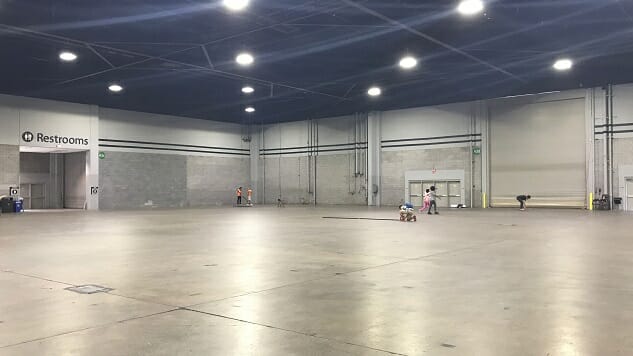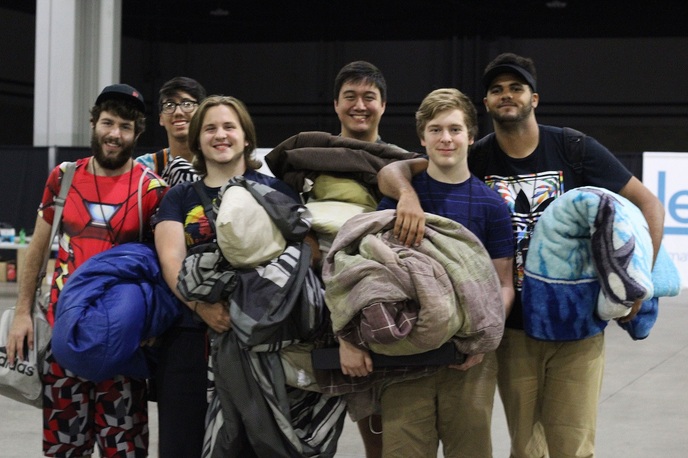DreamHack’s Sleeping Zone Isn’t as Nightmarish as You Think
Photos by Aiden Strawhun Games Features DreamHack
Why leave the LAN when you can sleep at the LAN?
While concrete floors, sleeping bags, tape boundaries and hundreds of people might sound a little reminiscent of summer camp, it’s actually part of a long-held tradition at the 72-hour international LAN and e-sports tournament DreamHack: the sleeping hall.
DreamHack’s beginnings were humble compared to the flashy digital festival it has become today. It officially originated in the Swedish city of Borlänge in 1997, but its true roots are actually in various Malung basements and school cafeterias from 1994 to 1996. With time, it quickly became the largest LAN party in Sweden, attracting people from all walks of life—but its home city only had one hotel.
Enter the sleeping hall. Instead of making its jet-lagged and caffeine-riddled participants sleep snuggly with their set-ups or along center hallways for three straight days, they came up with a more viable and safer option, because there were no other options if they couldn’t get into the sole hotel in the city.
For the first time in the United States, DreamHack was able to continue this sleeping hall tradition at its recent LAN in Atlanta, and will do so again at its Denver LAN in October. For $20 a night, participants could bring their own comforts of home to camp out on the concrete floors of the Georgia World Congress Center, or pay $60 to get a mattress and blankets provided by partner and sponsor Leesa.
Getting nightmares yet? Relax. The sleeping hall is far from glamourous, but it was organized. It was an exclusive area to those who paid, with access to showers, bathrooms and security at all hours. Those with sleeping passes would check in at the desk in front, get a sticker or ticket for easy access and find a spot on the floor that they wanted for their stay. And for those who did go premium, all 25 of those mattresses and blankets are being donated to a shelter in the city.
“We want to make sure that they feel like it’s an exclusive experience,” Alex Gruenstein, of the DreamHack sales team, says. “I mean, you go to a hotel and you get treated a certain way, and we want to make sure that everyone that’s using the sleeping hall feels like there’s some ownership over that area because they’ve chosen to participate in it.”
Atlanta’s sleeping hall is a tad different from the average sleeping halls over in Sweden. In Sweden, the sleeping halls have room for 3,000 to 4,000 people. Atlanta’s could only hold 300. And instead of claiming your sleeping territory and leaving your things in one spot for the whole weekend, it’s a get in, get out type of situation. Participants check in, find their spot, get some shut-eye and when they get up for the day, they take their things with them.
But why test something out like this in Atlanta of all places? It was never allowed in the event’s location in Austin. Gary Briggs, head of DreamHack’s North American events, and Grunstein both say it may have been due to convention center rules, or city ordinances, but could not confirm the exact reasons why. Even when perusing the Austin Convention Center rules, I couldn’t find the exact rule that the sleeping hall would be violating, even in the fire code. There are no specific rules in the center’s document that prohibit people from sleeping in the convention center either. Atlanta’s own World Congress Center has similar fire code regulations and space specifications to Austin’s Convention Center, so this seems to be more of an approval issue over anything else.
The only thing separating you from everyone else is a thin line of tape and a wall of air. There is no privacy, but that didn’t seem to be an issue for those who took advantage of the hall.
“It didn’t suck as much as you would think,” Brandon Brown says. “This morning was bad because I woke up literally shivering because they started blasting the AC—I think in preparation for all the people, which I get—but holy crap, it was freakin’ cold. I was dying!”
Brown and his four other friends came to DreamHack from Cincinnati, Ohio. Though they’ve long since graduated, they’re still close friends from high school and make an effort to go out and participate in tournaments around the country. For them, the sleeping hall was a great last-second arrangement after poor communication and a car ride that was “eight and some change.”
“We could just walk out and we’re already at the stuff,” Brown says. “Which is great because we stay up late every single tournament. This is not our first rodeo; we always stay at the venue way, way later than we should. In this case, we could literally just pop in, pop out. It was super simple.”
“They’ve got blowup beds; I’ve got a cot,” mother Elizabeth Hubbard says.
“Actually, I get the cot now,” her son, Miles, chimes in.
“Now, I don’t think Mommy’s gonna let that roll,” father Justin Hubbard says.
For the Hubbard family, from Macon, Ga., it was just as much about the convenience as it was the affordability. Though home is a bit closer than Ohio, the sleeping hall made for easy boarding during the LAN.
“It’s nice to be able to come out at any time of the night and go play some Tekken or find something to get into,” Justin says. “It’d be nice if they had some privacy partitions. I mean, it’s just one big room. I didn’t know that it wasn’t going to be that way; they said ‘Oh, you’re just gonna have a big concrete floor to sleep on,’ but they didn’t specify whether there would be cubicles or what it would be.
“It’s much cheaper. Twenty dollars a night versus $120 a night? Plus, you want to get up and get straight to the machines to get practice in before the tournaments. That’s an extra two hours every day of practice.”
“Here, [the sleeping hall is] mainly just to supplement, provide more options,” Briggs says. “It’s one of the biggest costs. If you’re flying in from across the country, the cost of getting into the event is a third of your hotel. Getting in the event, that’s not the problem. Buying that ticket, that’s not the problem. It’s everything else that goes around it. This is one way to work with that, but it’s also part of the culture. It’s not let’s just try to get around hotels, it is a part of this community. It’s a tradition.”
When it comes down to it, the sleeping hall is a lot more useful than it isn’t. It’s not meant to be anything fantastical or mindblowing. Instead, it’s very simple, providing just the barebones for those who need the amenity—if you can call it that—over those who are looking for comfort away from home. To that end, seeing this at larger conventions and LANs that attract people from all over the nation and world might be unlikely, but it shouldn’t be ruled out. Its convenience and affordability could make these wallet-munching events more accessible to people who wouldn’t otherwise have the chance to attend.
Aiden Strawhun is the Paste Games intern and gaming freelancer who somehow won an award once. On the off chance she isn’t drowning in words, she’s either stuck on Skyrim again or plotting to rule the world. Her work has also been seen on GameSpot, Extra Life and Naples Herald. Follow her on Twitter @AStraww.
